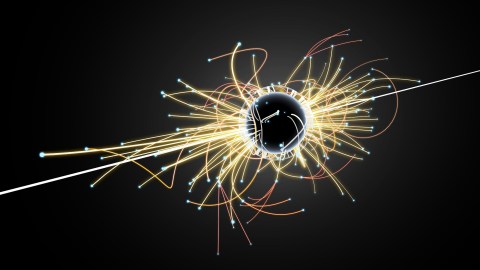Is dark matter real? Astronomy’s multi-decade mystery

- Despite recent advances in astrophysics and astronomy, scientists still don’t understand exactly how galaxies can exist.
- The most common explanation for this observational conundrum is a so-far undiscovered form of matter: dark matter.
- Still, dark matter has yet to be directly observed by scientists.
Modern astronomy is in a bit of turmoil. Astronomers understand how stars form, burn, and die, and they are improving their understanding of how planets assemble themselves into planetary systems like our own.
But astronomers have a problem: They don’t understand how galaxies can exist — a problem that has remained unsolved after decades of research.
The problem is relatively simple. Galaxies are collections of stars held together by gravity. Like our solar system, they rotate, with stars marching in stately paths, orbiting the galactic center. At any fixed distance from the center of the galaxy, stars moving faster require stronger gravity to hold them in that orbit. When astronomers measure the orbital speed of stars in galaxies at a range of distances from the center, they find that the stars are moving so fast that galaxies should be torn apart.
The most common explanation for this observational conundrum is a so-far undiscovered form of matter: dark matter. If it exists, dark matter exerts gravity, but it doesn’t emit light or any form of electromagnetic radiation. This means it can’t be seen by telescopes or any instrumentation that astronomers use to observe the cosmos. However, this invisible dark matter would add to any galaxy’s gravitational pull, explaining why the stars orbit the galaxy so quickly.
The problem with the dark matter hypothesis is that nobody knows what form dark matter takes. When the term was first proposed back in 1933 by the Swiss-American astronomer Fritz Zwicky, it was possible that the extra mass was simply clouds of hydrogen gas. Interstellar hydrogen gas is largely invisible to telescopes. However, as technology has improved, astronomers found ways to measure the amount of hydrogen gas in galaxies and, while there’s a lot of it out there, there’s not enough to explain the galaxy rotation mystery.
Other explanations that have been proposed include things like burned out stars, black holes, and other objects that are known to exist within galaxies but don’t emit light. However, astronomers searched for such objects (called MACHOs, short for MAssive Compact Halo Objects) in the 1990s and, again, while they found examples of MACHOs, there weren’t enough to explain the motion of stars in galaxies.
WIMPs
With some of the simpler explanations ruled out, scientists began to think that perhaps dark matter exists as a kind of a “gas,” or as never-before-seen particles. These particles are generically called “WIMPs,” short for “Weakly Interacting Massive Particles.” WIMPs, if they exist, are basically stable subatomic particles, with a mass somewhere in the range of the mass of a proton up to 10,000 protons, or even more.
Like all dark matter particle candidates, WIMPs interact gravitationally, but that “W” in the name means that they also interact via the weak nuclear force. The weak nuclear force is involved in some forms of radioactivity. much stronger than gravity, but unlike gravity’s infinite range, the weak nuclear force only acts over tiny distances — distances much smaller than a proton. If WIMPs exist, they pervade galaxies, including our Milky Way, and even our own solar system. Depending on the mass of the WIMPs, astronomers estimate that if you make a fist, one dark matter particle could be found inside it.
Scientists have been looking for direct and compelling evidence for the existence of WIMPs for many decades. They do this in several ways. For example, some WIMP theories suggest that WIMPs can be made in particle accelerators, like the Large Hadron Collider in Europe. Particle physicists look at their data, hoping to see the signature of WIMP production. No evidence has been observed so far.
Another way in which researchers look for WIMPs is directly observing dark matter particles that waft through the solar system. Scientists build very large detectors and cool them to very cold temperatures so the atoms of the detectors are moving slowly. They then put these detectors a half-mile or more underground to shield them from radiation from space. Then they wait, hoping that a dark matter particle will interact in their detector, disturbing one of the nearly stationary atoms.
But despite decades of efforts, no WIMPs have been observed. Predictions in the 1980s suggested researchers could expect to detect WIMPs at a particular rate. When no WIMPs were detected, researchers built a series of detectors with much greater sensitivity, all of which failed to find WIMPs. Current detectors are 100 million times more sensitive than the ones of the 1980s, and no definitive observation of WIMPs have occurred, including a very recent measurement by the LZ experiment, which employs 10 tons of xenon to achieve unparalleled sensitivity to WIMPs.
Looking forward
After decades of failing to detect dark matter, the scientific community is reexamining the situation. What is known for sure? Among other things, astronomers are certain that galaxies rotate faster than can be accounted for using the known laws of motion and gravity and the observed amount of matter. The dark matter hypothesis is a solution for a matter deficit, but perhaps it’s not the answer. Maybe the actual explanation is that the laws of motion and gravity need to be reexamined.
The name for such an approach is called MOND — short for “MOdifications of Newtonian Dynamics.” The first solution of this kind was proposed in the 1980s by Israeli physicist Mordehai Milgrom. He proposed that for the familiar motion we experience day to day, the laws of motion worked out by Isaac Newton back in the 1600s work just fine. But for very small forces and very small accelerations (like in the outskirts of galaxies), these laws needed to be adjusted. After making those adjustments, he could correctly predict the rotation of galaxies.
Although such an achievement might be viewed as a ringing success, he changed the equations to match the observed rotational properties of galaxies. That’s not the successful test of a theory. He knew the answer before he created the equations.
In order to test Milgrom’s theory, researchers needed to compare its predictions in other situations, such as applying it to the motion of large clusters of galaxies held together by their mutual gravitational attraction. MOND theory struggles to make a prediction of this motion that agrees with theory, and it also disagrees with other observations.
So, where are we? We are in that delightful phase of a scientific conundrum — a mystery still seeking a solution. While the majority of the scientific community comes down on the side of dark matter, the failure to prove dark matter’s existence is leading some to take a much more serious look at theories that modify accepted theories of gravity and motion.
If dark matter exists, it is five times more prevalent than ordinary atomic matter. If the correct answer is that we need to revisit our laws of motion and gravity, this will have significant consequences for our modeling of the history of the universe. The LZ experiment continues to operate, hoping to improve its already impressive performance, and researchers are building new detectors, hoping to find dark matter and definitively solve the mystery.





